Fiduciary Relationships: An In-depth Analysis of Equity and Succession
VerifiedAdded on 2023/06/11
|10
|2490
|191
Essay
AI Summary
This essay provides a detailed analysis of fiduciary relationships, focusing on the equitable duties and obligations of fiduciaries towards beneficiaries. It examines key case laws such as Queensland Mines Ltd v Hudson, Industrial Development Consultants Ltd v Cooley, and Boardman v Phipps to illustrate breaches of fiduciary duty and the importance of loyalty and good faith. The essay also discusses the concept of joint ventures and the fiduciary duties that arise within them, as seen in Chirnside v Fay, and addresses the issue of bribes and secret commissions, referencing Attorney-General for Hong Kong v Reid and FHR European Ventures LLP v Cedar Capital Partners LLC. Furthermore, the second part of the essay analyzes the basis of findings in Proprietors of Wakatu v Attorney General, highlighting the limitations and complexities in establishing fiduciary relationships. The essay concludes that fiduciary relationships require faith, confidence, honesty, and loyalty, emphasizing that trustees must act in the best interest of beneficiaries and avoid personal gain. Desklib provides students with access to a wide range of solved assignments and past papers to aid in their studies.
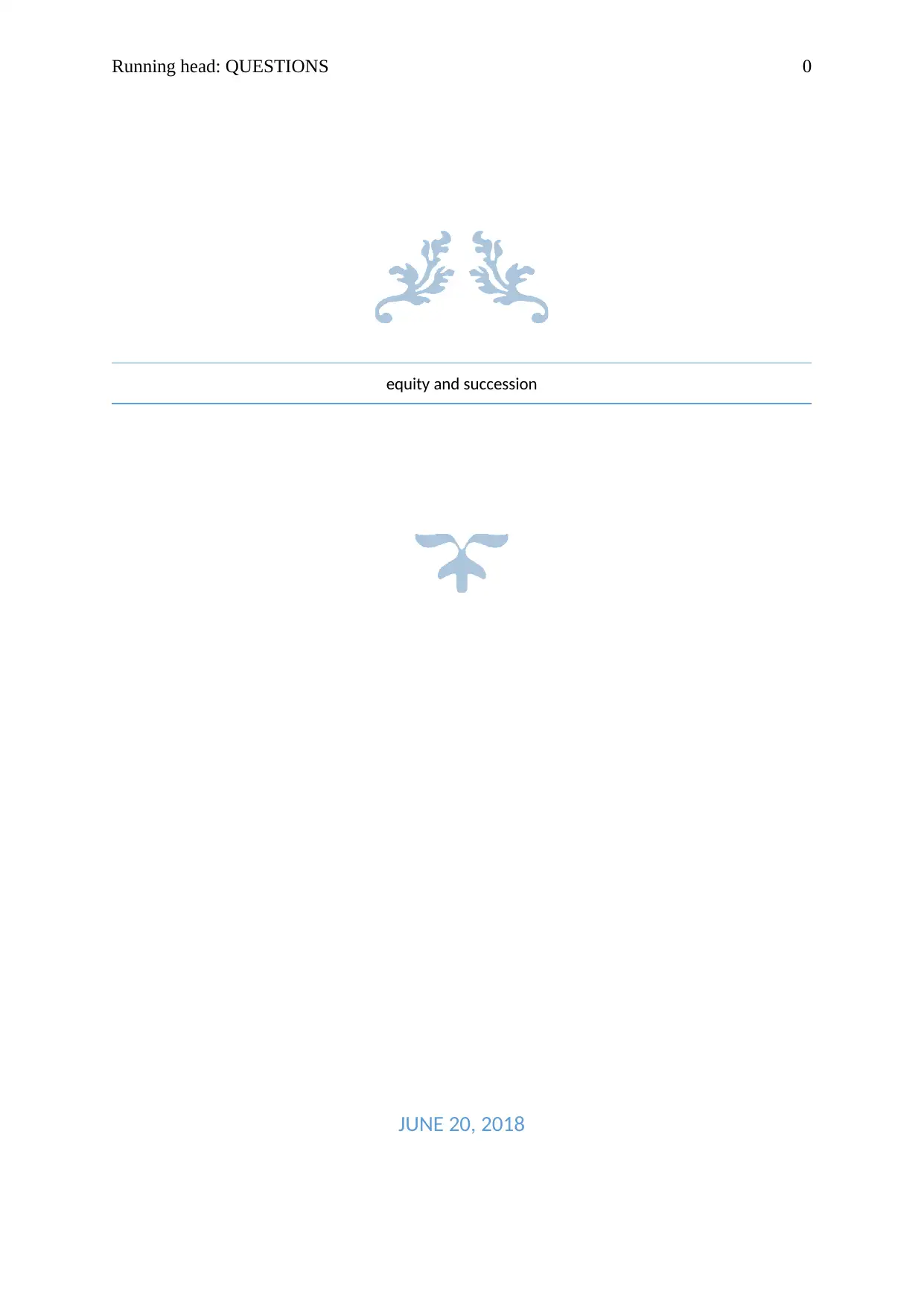
Running head: QUESTIONS 0
equity and succession
JUNE 20, 2018
equity and succession
JUNE 20, 2018
Paraphrase This Document
Need a fresh take? Get an instant paraphrase of this document with our AI Paraphraser
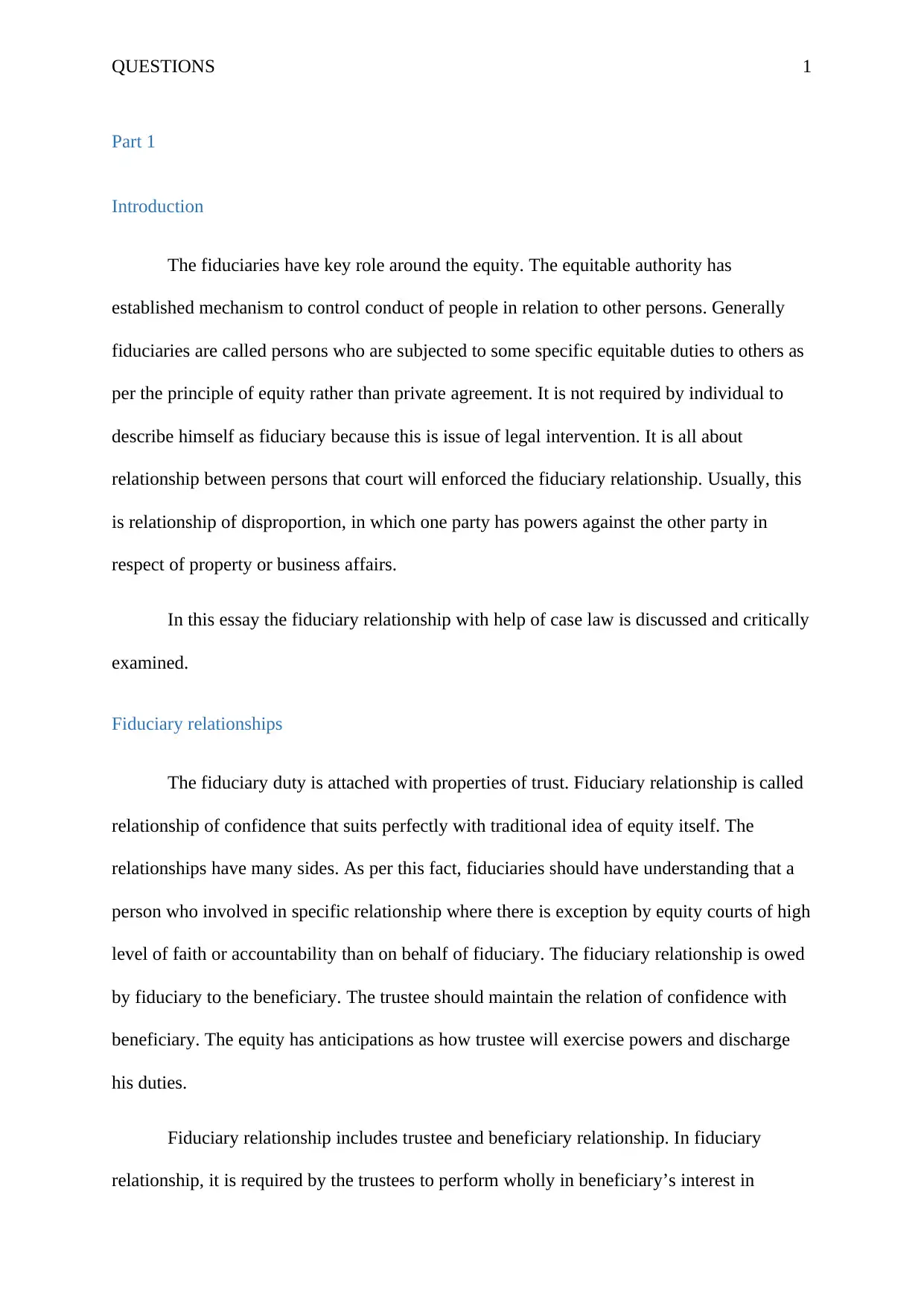
QUESTIONS 1
Part 1
Introduction
The fiduciaries have key role around the equity. The equitable authority has
established mechanism to control conduct of people in relation to other persons. Generally
fiduciaries are called persons who are subjected to some specific equitable duties to others as
per the principle of equity rather than private agreement. It is not required by individual to
describe himself as fiduciary because this is issue of legal intervention. It is all about
relationship between persons that court will enforced the fiduciary relationship. Usually, this
is relationship of disproportion, in which one party has powers against the other party in
respect of property or business affairs.
In this essay the fiduciary relationship with help of case law is discussed and critically
examined.
Fiduciary relationships
The fiduciary duty is attached with properties of trust. Fiduciary relationship is called
relationship of confidence that suits perfectly with traditional idea of equity itself. The
relationships have many sides. As per this fact, fiduciaries should have understanding that a
person who involved in specific relationship where there is exception by equity courts of high
level of faith or accountability than on behalf of fiduciary. The fiduciary relationship is owed
by fiduciary to the beneficiary. The trustee should maintain the relation of confidence with
beneficiary. The equity has anticipations as how trustee will exercise powers and discharge
his duties.
Fiduciary relationship includes trustee and beneficiary relationship. In fiduciary
relationship, it is required by the trustees to perform wholly in beneficiary’s interest in
Part 1
Introduction
The fiduciaries have key role around the equity. The equitable authority has
established mechanism to control conduct of people in relation to other persons. Generally
fiduciaries are called persons who are subjected to some specific equitable duties to others as
per the principle of equity rather than private agreement. It is not required by individual to
describe himself as fiduciary because this is issue of legal intervention. It is all about
relationship between persons that court will enforced the fiduciary relationship. Usually, this
is relationship of disproportion, in which one party has powers against the other party in
respect of property or business affairs.
In this essay the fiduciary relationship with help of case law is discussed and critically
examined.
Fiduciary relationships
The fiduciary duty is attached with properties of trust. Fiduciary relationship is called
relationship of confidence that suits perfectly with traditional idea of equity itself. The
relationships have many sides. As per this fact, fiduciaries should have understanding that a
person who involved in specific relationship where there is exception by equity courts of high
level of faith or accountability than on behalf of fiduciary. The fiduciary relationship is owed
by fiduciary to the beneficiary. The trustee should maintain the relation of confidence with
beneficiary. The equity has anticipations as how trustee will exercise powers and discharge
his duties.
Fiduciary relationship includes trustee and beneficiary relationship. In fiduciary
relationship, it is required by the trustees to perform wholly in beneficiary’s interest in
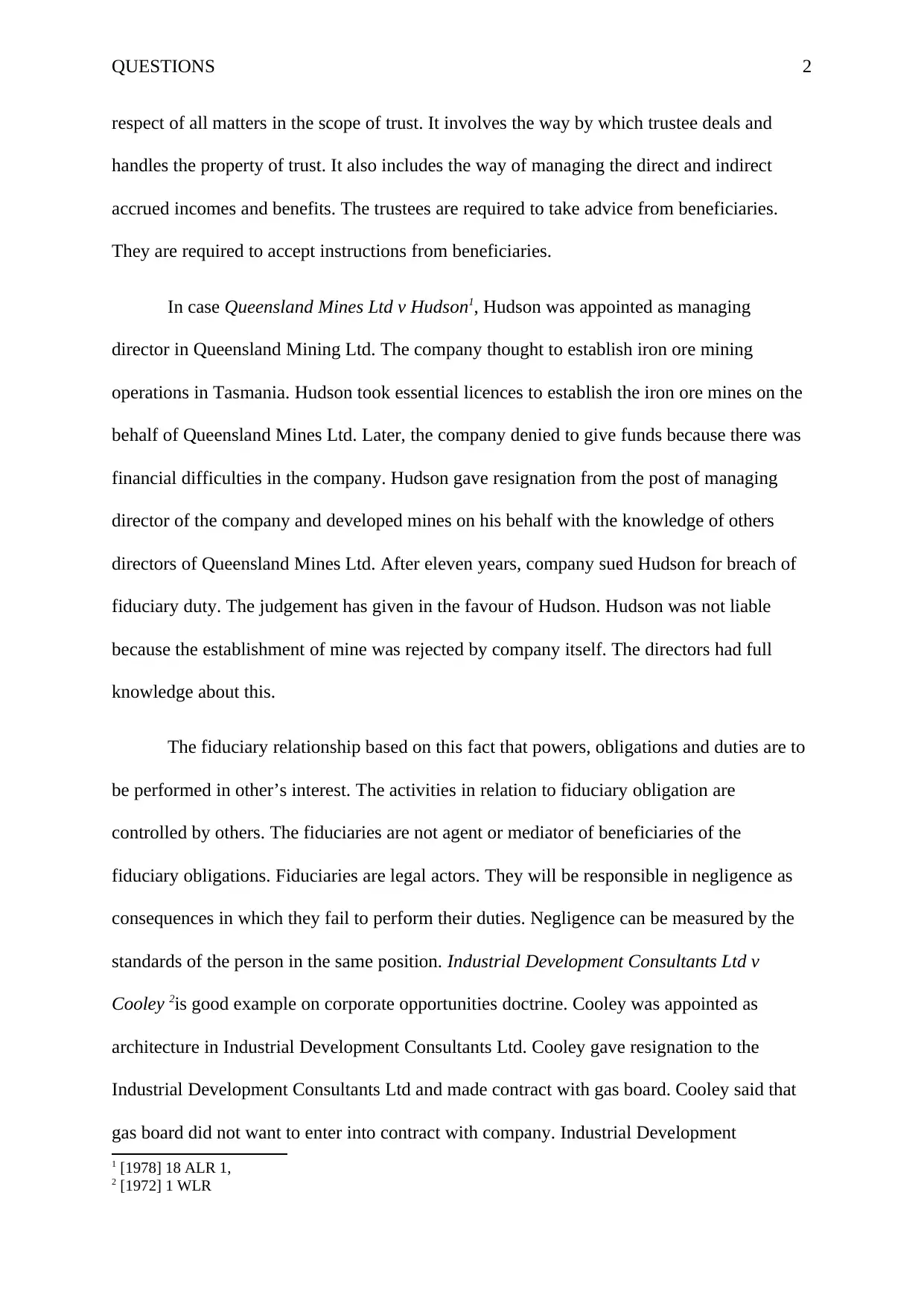
QUESTIONS 2
respect of all matters in the scope of trust. It involves the way by which trustee deals and
handles the property of trust. It also includes the way of managing the direct and indirect
accrued incomes and benefits. The trustees are required to take advice from beneficiaries.
They are required to accept instructions from beneficiaries.
In case Queensland Mines Ltd v Hudson1, Hudson was appointed as managing
director in Queensland Mining Ltd. The company thought to establish iron ore mining
operations in Tasmania. Hudson took essential licences to establish the iron ore mines on the
behalf of Queensland Mines Ltd. Later, the company denied to give funds because there was
financial difficulties in the company. Hudson gave resignation from the post of managing
director of the company and developed mines on his behalf with the knowledge of others
directors of Queensland Mines Ltd. After eleven years, company sued Hudson for breach of
fiduciary duty. The judgement has given in the favour of Hudson. Hudson was not liable
because the establishment of mine was rejected by company itself. The directors had full
knowledge about this.
The fiduciary relationship based on this fact that powers, obligations and duties are to
be performed in other’s interest. The activities in relation to fiduciary obligation are
controlled by others. The fiduciaries are not agent or mediator of beneficiaries of the
fiduciary obligations. Fiduciaries are legal actors. They will be responsible in negligence as
consequences in which they fail to perform their duties. Negligence can be measured by the
standards of the person in the same position. Industrial Development Consultants Ltd v
Cooley 2is good example on corporate opportunities doctrine. Cooley was appointed as
architecture in Industrial Development Consultants Ltd. Cooley gave resignation to the
Industrial Development Consultants Ltd and made contract with gas board. Cooley said that
gas board did not want to enter into contract with company. Industrial Development
1 [1978] 18 ALR 1,
2 [1972] 1 WLR
respect of all matters in the scope of trust. It involves the way by which trustee deals and
handles the property of trust. It also includes the way of managing the direct and indirect
accrued incomes and benefits. The trustees are required to take advice from beneficiaries.
They are required to accept instructions from beneficiaries.
In case Queensland Mines Ltd v Hudson1, Hudson was appointed as managing
director in Queensland Mining Ltd. The company thought to establish iron ore mining
operations in Tasmania. Hudson took essential licences to establish the iron ore mines on the
behalf of Queensland Mines Ltd. Later, the company denied to give funds because there was
financial difficulties in the company. Hudson gave resignation from the post of managing
director of the company and developed mines on his behalf with the knowledge of others
directors of Queensland Mines Ltd. After eleven years, company sued Hudson for breach of
fiduciary duty. The judgement has given in the favour of Hudson. Hudson was not liable
because the establishment of mine was rejected by company itself. The directors had full
knowledge about this.
The fiduciary relationship based on this fact that powers, obligations and duties are to
be performed in other’s interest. The activities in relation to fiduciary obligation are
controlled by others. The fiduciaries are not agent or mediator of beneficiaries of the
fiduciary obligations. Fiduciaries are legal actors. They will be responsible in negligence as
consequences in which they fail to perform their duties. Negligence can be measured by the
standards of the person in the same position. Industrial Development Consultants Ltd v
Cooley 2is good example on corporate opportunities doctrine. Cooley was appointed as
architecture in Industrial Development Consultants Ltd. Cooley gave resignation to the
Industrial Development Consultants Ltd and made contract with gas board. Cooley said that
gas board did not want to enter into contract with company. Industrial Development
1 [1978] 18 ALR 1,
2 [1972] 1 WLR
⊘ This is a preview!⊘
Do you want full access?
Subscribe today to unlock all pages.

Trusted by 1+ million students worldwide
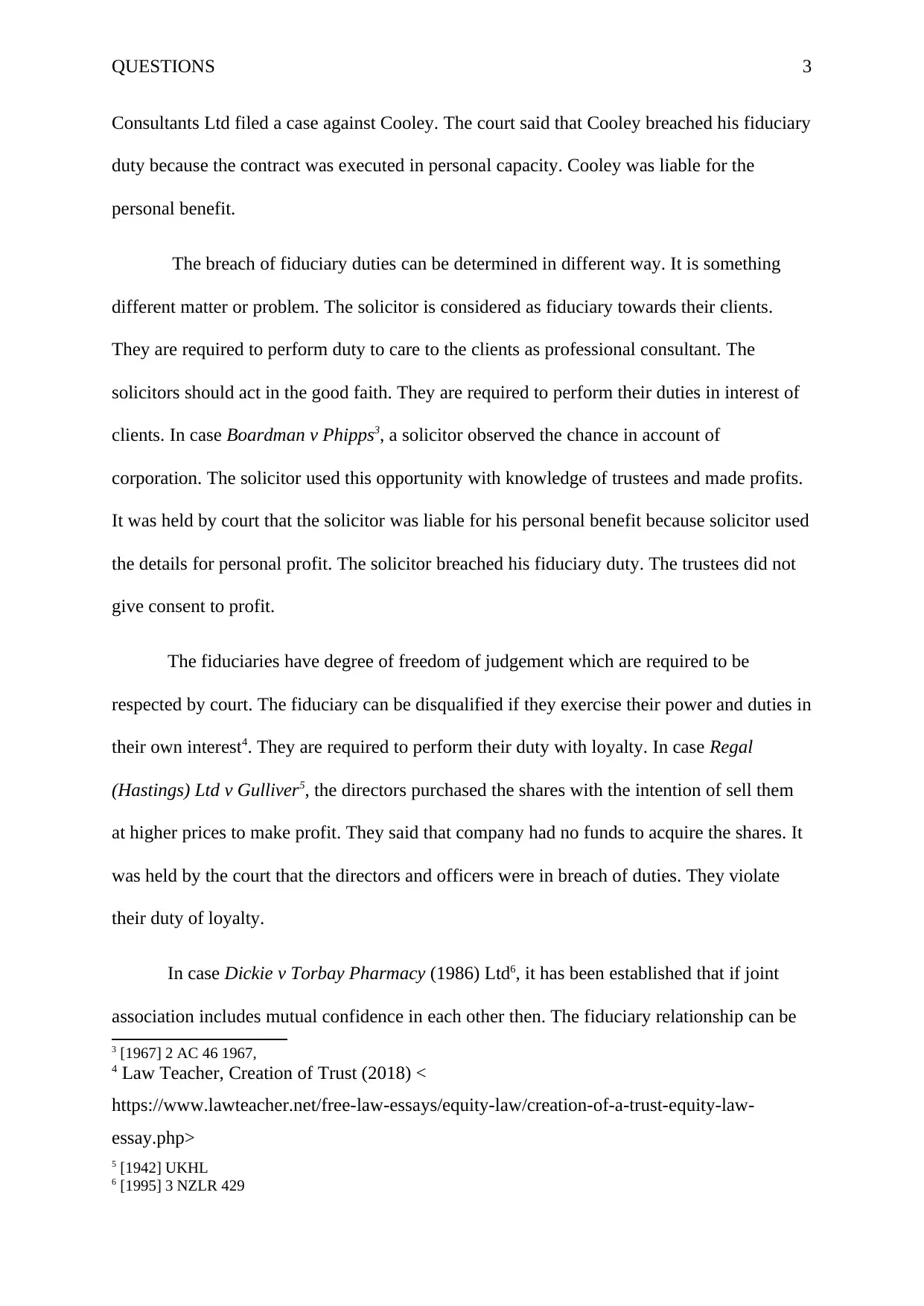
QUESTIONS 3
Consultants Ltd filed a case against Cooley. The court said that Cooley breached his fiduciary
duty because the contract was executed in personal capacity. Cooley was liable for the
personal benefit.
The breach of fiduciary duties can be determined in different way. It is something
different matter or problem. The solicitor is considered as fiduciary towards their clients.
They are required to perform duty to care to the clients as professional consultant. The
solicitors should act in the good faith. They are required to perform their duties in interest of
clients. In case Boardman v Phipps3, a solicitor observed the chance in account of
corporation. The solicitor used this opportunity with knowledge of trustees and made profits.
It was held by court that the solicitor was liable for his personal benefit because solicitor used
the details for personal profit. The solicitor breached his fiduciary duty. The trustees did not
give consent to profit.
The fiduciaries have degree of freedom of judgement which are required to be
respected by court. The fiduciary can be disqualified if they exercise their power and duties in
their own interest4. They are required to perform their duty with loyalty. In case Regal
(Hastings) Ltd v Gulliver5, the directors purchased the shares with the intention of sell them
at higher prices to make profit. They said that company had no funds to acquire the shares. It
was held by the court that the directors and officers were in breach of duties. They violate
their duty of loyalty.
In case Dickie v Torbay Pharmacy (1986) Ltd6, it has been established that if joint
association includes mutual confidence in each other then. The fiduciary relationship can be
3 [1967] 2 AC 46 1967,
4 Law Teacher, Creation of Trust (2018) <
https://www.lawteacher.net/free-law-essays/equity-law/creation-of-a-trust-equity-law-
essay.php>
5 [1942] UKHL
6 [1995] 3 NZLR 429
Consultants Ltd filed a case against Cooley. The court said that Cooley breached his fiduciary
duty because the contract was executed in personal capacity. Cooley was liable for the
personal benefit.
The breach of fiduciary duties can be determined in different way. It is something
different matter or problem. The solicitor is considered as fiduciary towards their clients.
They are required to perform duty to care to the clients as professional consultant. The
solicitors should act in the good faith. They are required to perform their duties in interest of
clients. In case Boardman v Phipps3, a solicitor observed the chance in account of
corporation. The solicitor used this opportunity with knowledge of trustees and made profits.
It was held by court that the solicitor was liable for his personal benefit because solicitor used
the details for personal profit. The solicitor breached his fiduciary duty. The trustees did not
give consent to profit.
The fiduciaries have degree of freedom of judgement which are required to be
respected by court. The fiduciary can be disqualified if they exercise their power and duties in
their own interest4. They are required to perform their duty with loyalty. In case Regal
(Hastings) Ltd v Gulliver5, the directors purchased the shares with the intention of sell them
at higher prices to make profit. They said that company had no funds to acquire the shares. It
was held by the court that the directors and officers were in breach of duties. They violate
their duty of loyalty.
In case Dickie v Torbay Pharmacy (1986) Ltd6, it has been established that if joint
association includes mutual confidence in each other then. The fiduciary relationship can be
3 [1967] 2 AC 46 1967,
4 Law Teacher, Creation of Trust (2018) <
https://www.lawteacher.net/free-law-essays/equity-law/creation-of-a-trust-equity-law-
essay.php>
5 [1942] UKHL
6 [1995] 3 NZLR 429
Paraphrase This Document
Need a fresh take? Get an instant paraphrase of this document with our AI Paraphraser
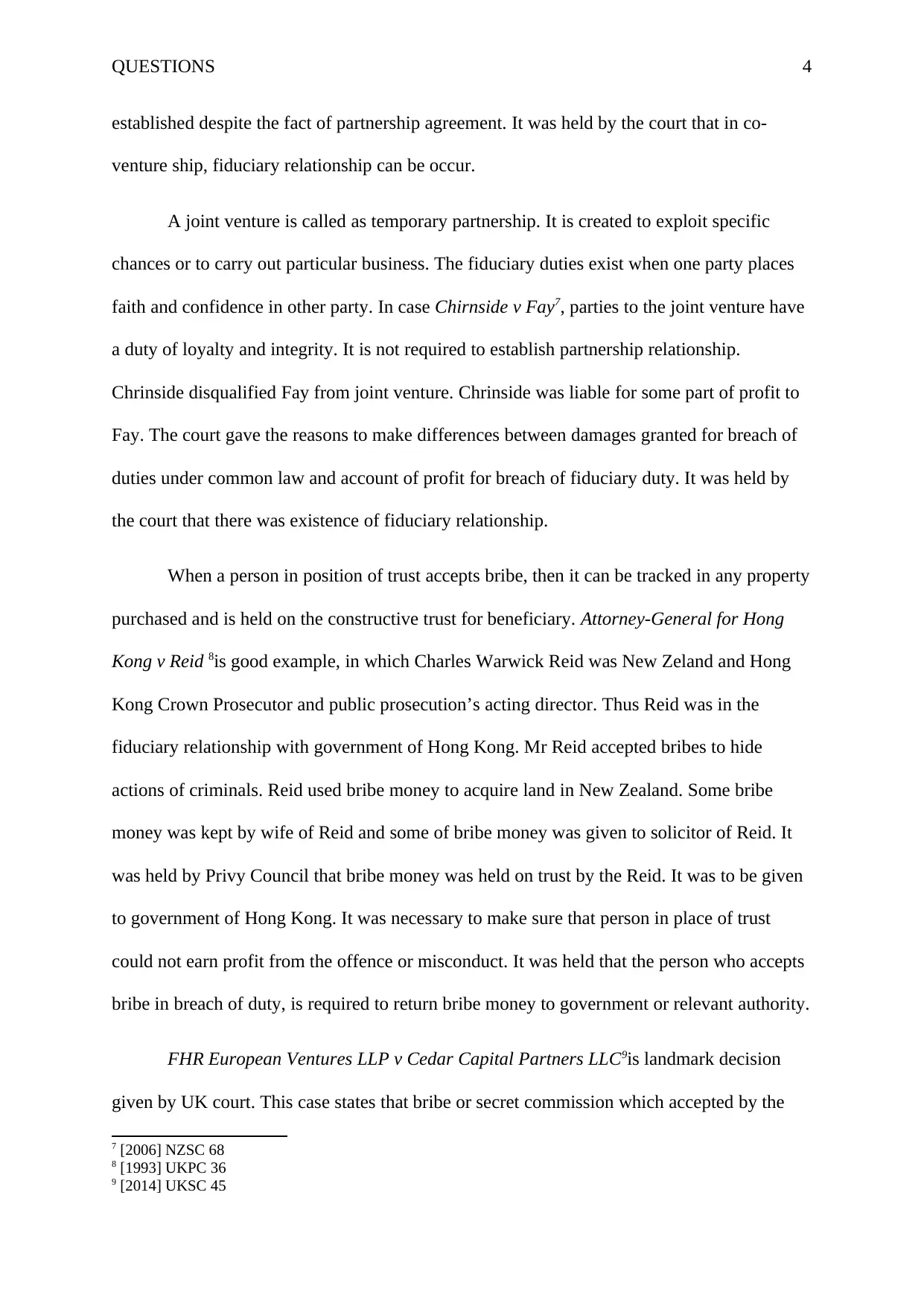
QUESTIONS 4
established despite the fact of partnership agreement. It was held by the court that in co-
venture ship, fiduciary relationship can be occur.
A joint venture is called as temporary partnership. It is created to exploit specific
chances or to carry out particular business. The fiduciary duties exist when one party places
faith and confidence in other party. In case Chirnside v Fay7, parties to the joint venture have
a duty of loyalty and integrity. It is not required to establish partnership relationship.
Chrinside disqualified Fay from joint venture. Chrinside was liable for some part of profit to
Fay. The court gave the reasons to make differences between damages granted for breach of
duties under common law and account of profit for breach of fiduciary duty. It was held by
the court that there was existence of fiduciary relationship.
When a person in position of trust accepts bribe, then it can be tracked in any property
purchased and is held on the constructive trust for beneficiary. Attorney-General for Hong
Kong v Reid 8is good example, in which Charles Warwick Reid was New Zeland and Hong
Kong Crown Prosecutor and public prosecution’s acting director. Thus Reid was in the
fiduciary relationship with government of Hong Kong. Mr Reid accepted bribes to hide
actions of criminals. Reid used bribe money to acquire land in New Zealand. Some bribe
money was kept by wife of Reid and some of bribe money was given to solicitor of Reid. It
was held by Privy Council that bribe money was held on trust by the Reid. It was to be given
to government of Hong Kong. It was necessary to make sure that person in place of trust
could not earn profit from the offence or misconduct. It was held that the person who accepts
bribe in breach of duty, is required to return bribe money to government or relevant authority.
FHR European Ventures LLP v Cedar Capital Partners LLC9is landmark decision
given by UK court. This case states that bribe or secret commission which accepted by the
7 [2006] NZSC 68
8 [1993] UKPC 36
9 [2014] UKSC 45
established despite the fact of partnership agreement. It was held by the court that in co-
venture ship, fiduciary relationship can be occur.
A joint venture is called as temporary partnership. It is created to exploit specific
chances or to carry out particular business. The fiduciary duties exist when one party places
faith and confidence in other party. In case Chirnside v Fay7, parties to the joint venture have
a duty of loyalty and integrity. It is not required to establish partnership relationship.
Chrinside disqualified Fay from joint venture. Chrinside was liable for some part of profit to
Fay. The court gave the reasons to make differences between damages granted for breach of
duties under common law and account of profit for breach of fiduciary duty. It was held by
the court that there was existence of fiduciary relationship.
When a person in position of trust accepts bribe, then it can be tracked in any property
purchased and is held on the constructive trust for beneficiary. Attorney-General for Hong
Kong v Reid 8is good example, in which Charles Warwick Reid was New Zeland and Hong
Kong Crown Prosecutor and public prosecution’s acting director. Thus Reid was in the
fiduciary relationship with government of Hong Kong. Mr Reid accepted bribes to hide
actions of criminals. Reid used bribe money to acquire land in New Zealand. Some bribe
money was kept by wife of Reid and some of bribe money was given to solicitor of Reid. It
was held by Privy Council that bribe money was held on trust by the Reid. It was to be given
to government of Hong Kong. It was necessary to make sure that person in place of trust
could not earn profit from the offence or misconduct. It was held that the person who accepts
bribe in breach of duty, is required to return bribe money to government or relevant authority.
FHR European Ventures LLP v Cedar Capital Partners LLC9is landmark decision
given by UK court. This case states that bribe or secret commission which accepted by the
7 [2006] NZSC 68
8 [1993] UKPC 36
9 [2014] UKSC 45
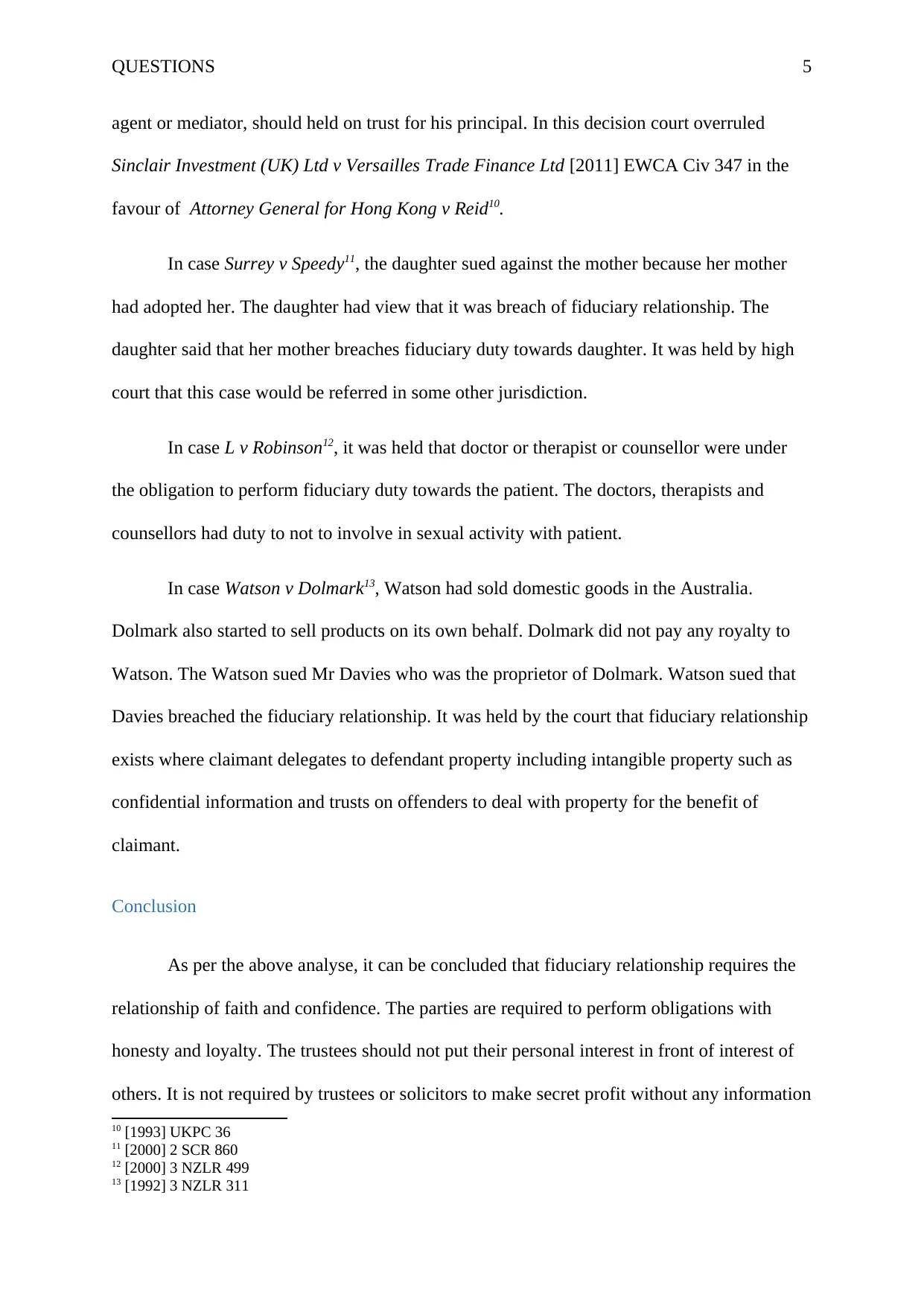
QUESTIONS 5
agent or mediator, should held on trust for his principal. In this decision court overruled
Sinclair Investment (UK) Ltd v Versailles Trade Finance Ltd [2011] EWCA Civ 347 in the
favour of Attorney General for Hong Kong v Reid10.
In case Surrey v Speedy11, the daughter sued against the mother because her mother
had adopted her. The daughter had view that it was breach of fiduciary relationship. The
daughter said that her mother breaches fiduciary duty towards daughter. It was held by high
court that this case would be referred in some other jurisdiction.
In case L v Robinson12, it was held that doctor or therapist or counsellor were under
the obligation to perform fiduciary duty towards the patient. The doctors, therapists and
counsellors had duty to not to involve in sexual activity with patient.
In case Watson v Dolmark13, Watson had sold domestic goods in the Australia.
Dolmark also started to sell products on its own behalf. Dolmark did not pay any royalty to
Watson. The Watson sued Mr Davies who was the proprietor of Dolmark. Watson sued that
Davies breached the fiduciary relationship. It was held by the court that fiduciary relationship
exists where claimant delegates to defendant property including intangible property such as
confidential information and trusts on offenders to deal with property for the benefit of
claimant.
Conclusion
As per the above analyse, it can be concluded that fiduciary relationship requires the
relationship of faith and confidence. The parties are required to perform obligations with
honesty and loyalty. The trustees should not put their personal interest in front of interest of
others. It is not required by trustees or solicitors to make secret profit without any information
10 [1993] UKPC 36
11 [2000] 2 SCR 860
12 [2000] 3 NZLR 499
13 [1992] 3 NZLR 311
agent or mediator, should held on trust for his principal. In this decision court overruled
Sinclair Investment (UK) Ltd v Versailles Trade Finance Ltd [2011] EWCA Civ 347 in the
favour of Attorney General for Hong Kong v Reid10.
In case Surrey v Speedy11, the daughter sued against the mother because her mother
had adopted her. The daughter had view that it was breach of fiduciary relationship. The
daughter said that her mother breaches fiduciary duty towards daughter. It was held by high
court that this case would be referred in some other jurisdiction.
In case L v Robinson12, it was held that doctor or therapist or counsellor were under
the obligation to perform fiduciary duty towards the patient. The doctors, therapists and
counsellors had duty to not to involve in sexual activity with patient.
In case Watson v Dolmark13, Watson had sold domestic goods in the Australia.
Dolmark also started to sell products on its own behalf. Dolmark did not pay any royalty to
Watson. The Watson sued Mr Davies who was the proprietor of Dolmark. Watson sued that
Davies breached the fiduciary relationship. It was held by the court that fiduciary relationship
exists where claimant delegates to defendant property including intangible property such as
confidential information and trusts on offenders to deal with property for the benefit of
claimant.
Conclusion
As per the above analyse, it can be concluded that fiduciary relationship requires the
relationship of faith and confidence. The parties are required to perform obligations with
honesty and loyalty. The trustees should not put their personal interest in front of interest of
others. It is not required by trustees or solicitors to make secret profit without any information
10 [1993] UKPC 36
11 [2000] 2 SCR 860
12 [2000] 3 NZLR 499
13 [1992] 3 NZLR 311
⊘ This is a preview!⊘
Do you want full access?
Subscribe today to unlock all pages.

Trusted by 1+ million students worldwide
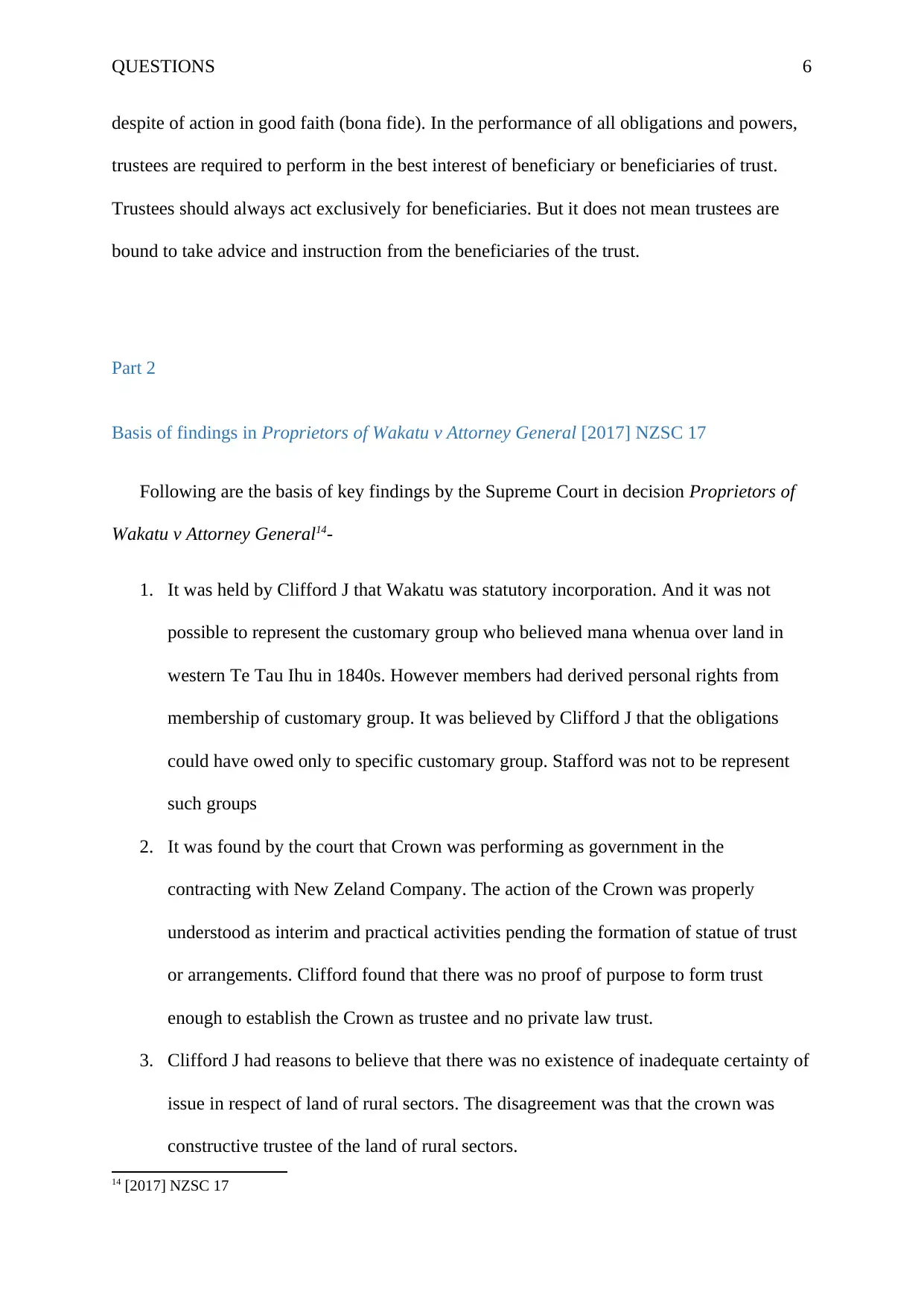
QUESTIONS 6
despite of action in good faith (bona fide). In the performance of all obligations and powers,
trustees are required to perform in the best interest of beneficiary or beneficiaries of trust.
Trustees should always act exclusively for beneficiaries. But it does not mean trustees are
bound to take advice and instruction from the beneficiaries of the trust.
Part 2
Basis of findings in Proprietors of Wakatu v Attorney General [2017] NZSC 17
Following are the basis of key findings by the Supreme Court in decision Proprietors of
Wakatu v Attorney General14-
1. It was held by Clifford J that Wakatu was statutory incorporation. And it was not
possible to represent the customary group who believed mana whenua over land in
western Te Tau Ihu in 1840s. However members had derived personal rights from
membership of customary group. It was believed by Clifford J that the obligations
could have owed only to specific customary group. Stafford was not to be represent
such groups
2. It was found by the court that Crown was performing as government in the
contracting with New Zeland Company. The action of the Crown was properly
understood as interim and practical activities pending the formation of statue of trust
or arrangements. Clifford found that there was no proof of purpose to form trust
enough to establish the Crown as trustee and no private law trust.
3. Clifford J had reasons to believe that there was no existence of inadequate certainty of
issue in respect of land of rural sectors. The disagreement was that the crown was
constructive trustee of the land of rural sectors.
14 [2017] NZSC 17
despite of action in good faith (bona fide). In the performance of all obligations and powers,
trustees are required to perform in the best interest of beneficiary or beneficiaries of trust.
Trustees should always act exclusively for beneficiaries. But it does not mean trustees are
bound to take advice and instruction from the beneficiaries of the trust.
Part 2
Basis of findings in Proprietors of Wakatu v Attorney General [2017] NZSC 17
Following are the basis of key findings by the Supreme Court in decision Proprietors of
Wakatu v Attorney General14-
1. It was held by Clifford J that Wakatu was statutory incorporation. And it was not
possible to represent the customary group who believed mana whenua over land in
western Te Tau Ihu in 1840s. However members had derived personal rights from
membership of customary group. It was believed by Clifford J that the obligations
could have owed only to specific customary group. Stafford was not to be represent
such groups
2. It was found by the court that Crown was performing as government in the
contracting with New Zeland Company. The action of the Crown was properly
understood as interim and practical activities pending the formation of statue of trust
or arrangements. Clifford found that there was no proof of purpose to form trust
enough to establish the Crown as trustee and no private law trust.
3. Clifford J had reasons to believe that there was no existence of inadequate certainty of
issue in respect of land of rural sectors. The disagreement was that the crown was
constructive trustee of the land of rural sectors.
14 [2017] NZSC 17
Paraphrase This Document
Need a fresh take? Get an instant paraphrase of this document with our AI Paraphraser
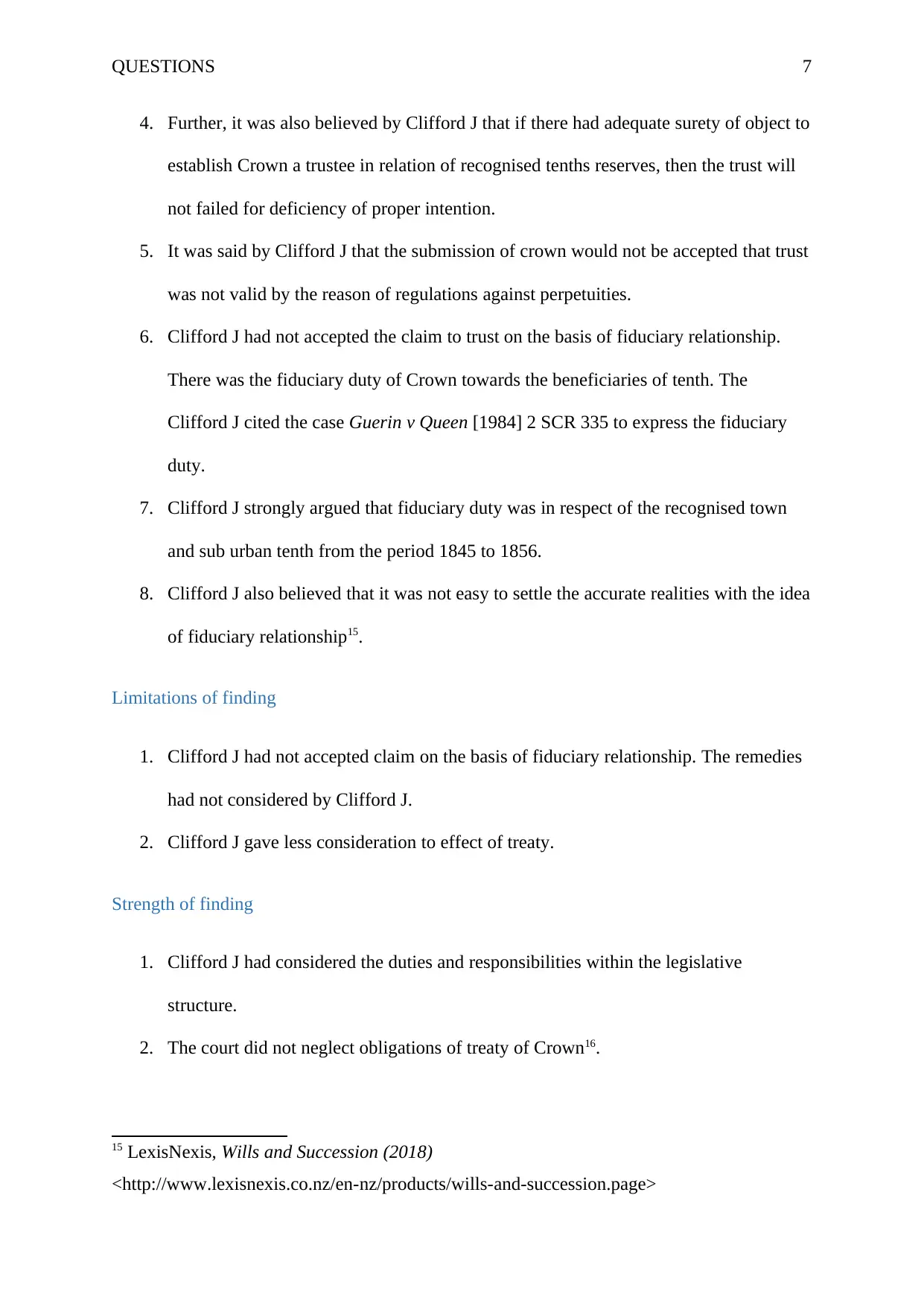
QUESTIONS 7
4. Further, it was also believed by Clifford J that if there had adequate surety of object to
establish Crown a trustee in relation of recognised tenths reserves, then the trust will
not failed for deficiency of proper intention.
5. It was said by Clifford J that the submission of crown would not be accepted that trust
was not valid by the reason of regulations against perpetuities.
6. Clifford J had not accepted the claim to trust on the basis of fiduciary relationship.
There was the fiduciary duty of Crown towards the beneficiaries of tenth. The
Clifford J cited the case Guerin v Queen [1984] 2 SCR 335 to express the fiduciary
duty.
7. Clifford J strongly argued that fiduciary duty was in respect of the recognised town
and sub urban tenth from the period 1845 to 1856.
8. Clifford J also believed that it was not easy to settle the accurate realities with the idea
of fiduciary relationship15.
Limitations of finding
1. Clifford J had not accepted claim on the basis of fiduciary relationship. The remedies
had not considered by Clifford J.
2. Clifford J gave less consideration to effect of treaty.
Strength of finding
1. Clifford J had considered the duties and responsibilities within the legislative
structure.
2. The court did not neglect obligations of treaty of Crown16.
15 LexisNexis, Wills and Succession (2018)
<http://www.lexisnexis.co.nz/en-nz/products/wills-and-succession.page>
4. Further, it was also believed by Clifford J that if there had adequate surety of object to
establish Crown a trustee in relation of recognised tenths reserves, then the trust will
not failed for deficiency of proper intention.
5. It was said by Clifford J that the submission of crown would not be accepted that trust
was not valid by the reason of regulations against perpetuities.
6. Clifford J had not accepted the claim to trust on the basis of fiduciary relationship.
There was the fiduciary duty of Crown towards the beneficiaries of tenth. The
Clifford J cited the case Guerin v Queen [1984] 2 SCR 335 to express the fiduciary
duty.
7. Clifford J strongly argued that fiduciary duty was in respect of the recognised town
and sub urban tenth from the period 1845 to 1856.
8. Clifford J also believed that it was not easy to settle the accurate realities with the idea
of fiduciary relationship15.
Limitations of finding
1. Clifford J had not accepted claim on the basis of fiduciary relationship. The remedies
had not considered by Clifford J.
2. Clifford J gave less consideration to effect of treaty.
Strength of finding
1. Clifford J had considered the duties and responsibilities within the legislative
structure.
2. The court did not neglect obligations of treaty of Crown16.
15 LexisNexis, Wills and Succession (2018)
<http://www.lexisnexis.co.nz/en-nz/products/wills-and-succession.page>
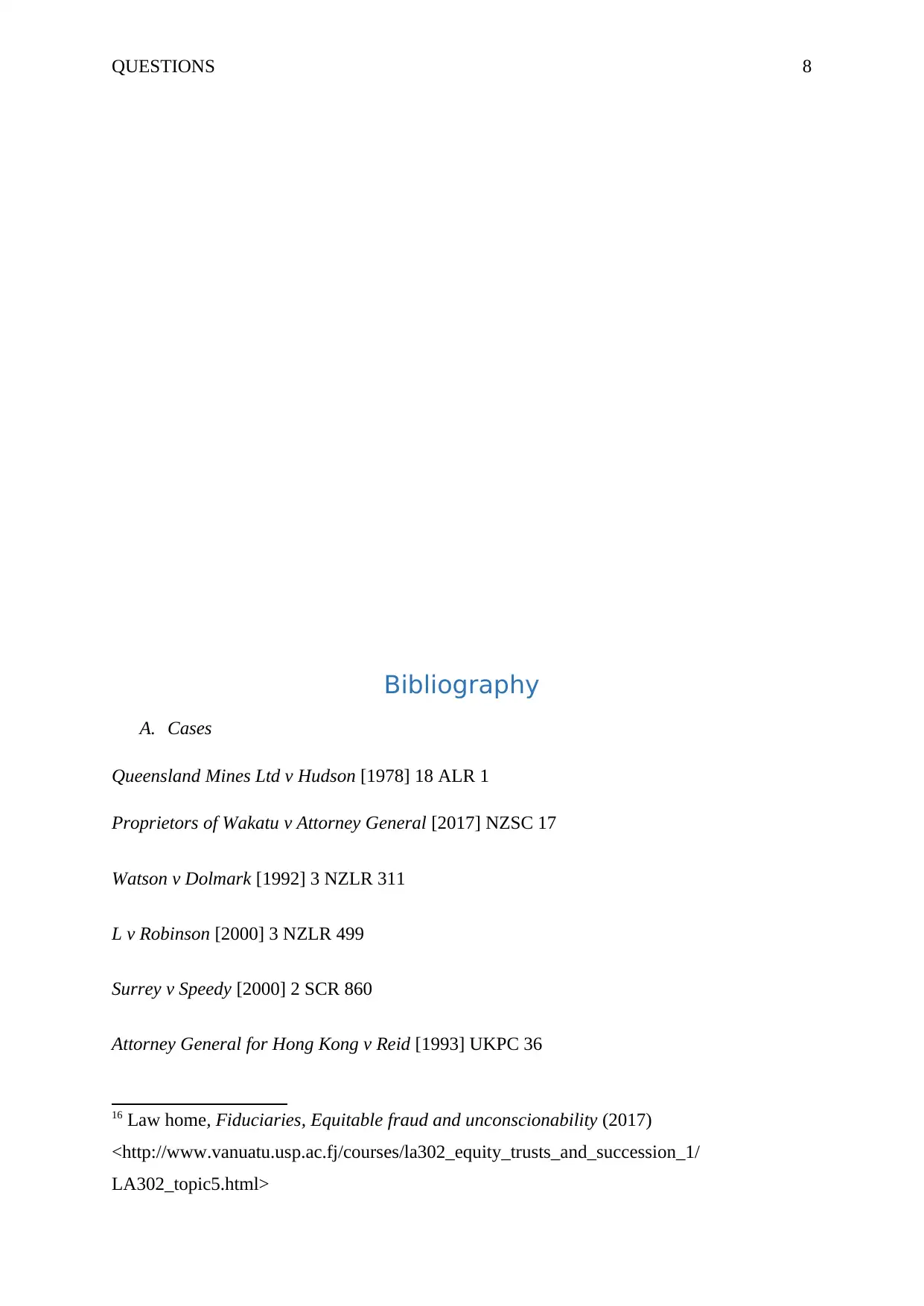
QUESTIONS 8
Bibliography
A. Cases
Queensland Mines Ltd v Hudson [1978] 18 ALR 1
Proprietors of Wakatu v Attorney General [2017] NZSC 17
Watson v Dolmark [1992] 3 NZLR 311
L v Robinson [2000] 3 NZLR 499
Surrey v Speedy [2000] 2 SCR 860
Attorney General for Hong Kong v Reid [1993] UKPC 36
16 Law home, Fiduciaries, Equitable fraud and unconscionability (2017)
<http://www.vanuatu.usp.ac.fj/courses/la302_equity_trusts_and_succession_1/
LA302_topic5.html>
Bibliography
A. Cases
Queensland Mines Ltd v Hudson [1978] 18 ALR 1
Proprietors of Wakatu v Attorney General [2017] NZSC 17
Watson v Dolmark [1992] 3 NZLR 311
L v Robinson [2000] 3 NZLR 499
Surrey v Speedy [2000] 2 SCR 860
Attorney General for Hong Kong v Reid [1993] UKPC 36
16 Law home, Fiduciaries, Equitable fraud and unconscionability (2017)
<http://www.vanuatu.usp.ac.fj/courses/la302_equity_trusts_and_succession_1/
LA302_topic5.html>
⊘ This is a preview!⊘
Do you want full access?
Subscribe today to unlock all pages.

Trusted by 1+ million students worldwide
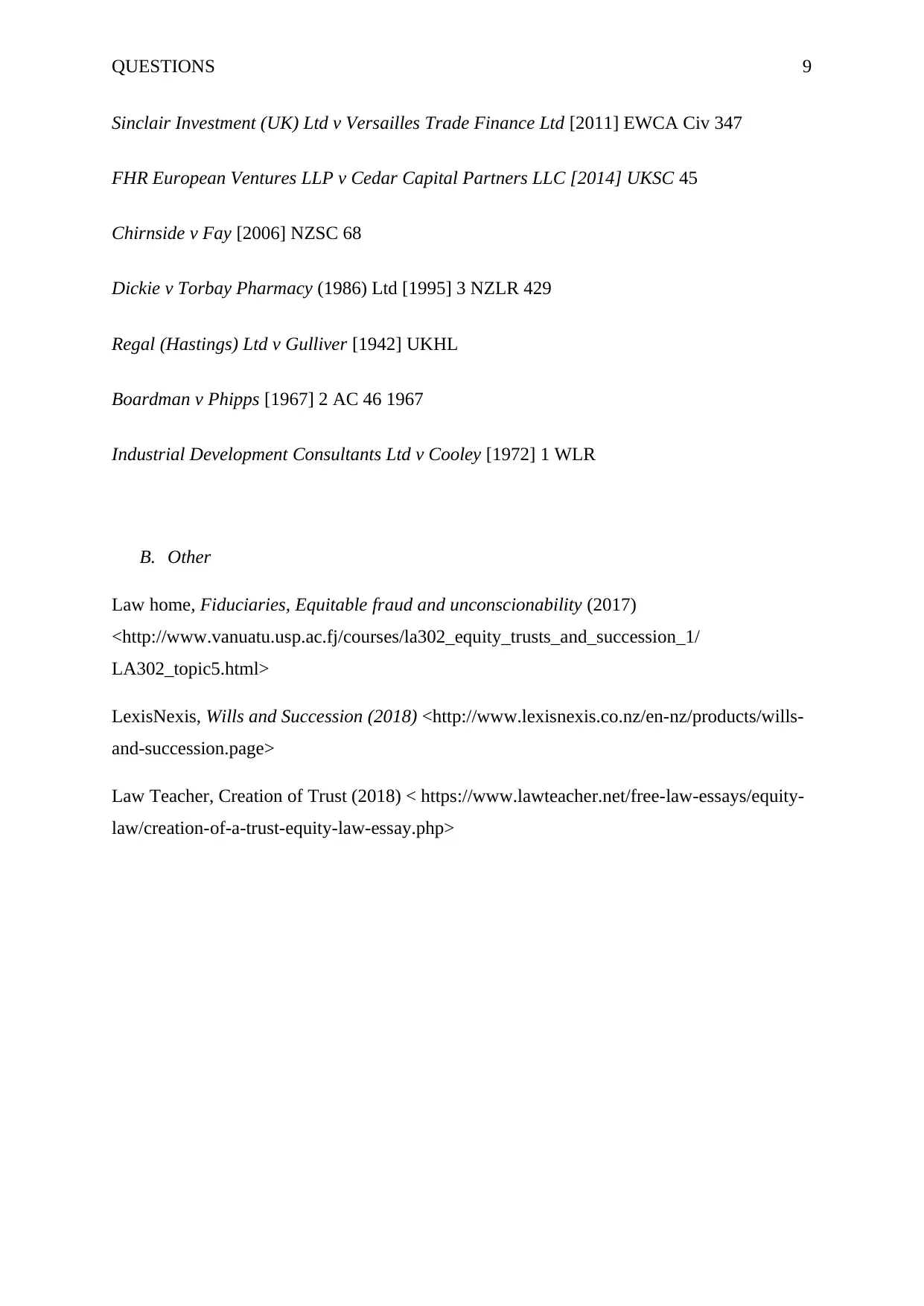
QUESTIONS 9
Sinclair Investment (UK) Ltd v Versailles Trade Finance Ltd [2011] EWCA Civ 347
FHR European Ventures LLP v Cedar Capital Partners LLC [2014] UKSC 45
Chirnside v Fay [2006] NZSC 68
Dickie v Torbay Pharmacy (1986) Ltd [1995] 3 NZLR 429
Regal (Hastings) Ltd v Gulliver [1942] UKHL
Boardman v Phipps [1967] 2 AC 46 1967
Industrial Development Consultants Ltd v Cooley [1972] 1 WLR
B. Other
Law home, Fiduciaries, Equitable fraud and unconscionability (2017)
<http://www.vanuatu.usp.ac.fj/courses/la302_equity_trusts_and_succession_1/
LA302_topic5.html>
LexisNexis, Wills and Succession (2018) <http://www.lexisnexis.co.nz/en-nz/products/wills-
and-succession.page>
Law Teacher, Creation of Trust (2018) < https://www.lawteacher.net/free-law-essays/equity-
law/creation-of-a-trust-equity-law-essay.php>
Sinclair Investment (UK) Ltd v Versailles Trade Finance Ltd [2011] EWCA Civ 347
FHR European Ventures LLP v Cedar Capital Partners LLC [2014] UKSC 45
Chirnside v Fay [2006] NZSC 68
Dickie v Torbay Pharmacy (1986) Ltd [1995] 3 NZLR 429
Regal (Hastings) Ltd v Gulliver [1942] UKHL
Boardman v Phipps [1967] 2 AC 46 1967
Industrial Development Consultants Ltd v Cooley [1972] 1 WLR
B. Other
Law home, Fiduciaries, Equitable fraud and unconscionability (2017)
<http://www.vanuatu.usp.ac.fj/courses/la302_equity_trusts_and_succession_1/
LA302_topic5.html>
LexisNexis, Wills and Succession (2018) <http://www.lexisnexis.co.nz/en-nz/products/wills-
and-succession.page>
Law Teacher, Creation of Trust (2018) < https://www.lawteacher.net/free-law-essays/equity-
law/creation-of-a-trust-equity-law-essay.php>
1 out of 10
Related Documents
Your All-in-One AI-Powered Toolkit for Academic Success.
+13062052269
info@desklib.com
Available 24*7 on WhatsApp / Email
![[object Object]](/_next/static/media/star-bottom.7253800d.svg)
Unlock your academic potential
Copyright © 2020–2025 A2Z Services. All Rights Reserved. Developed and managed by ZUCOL.





